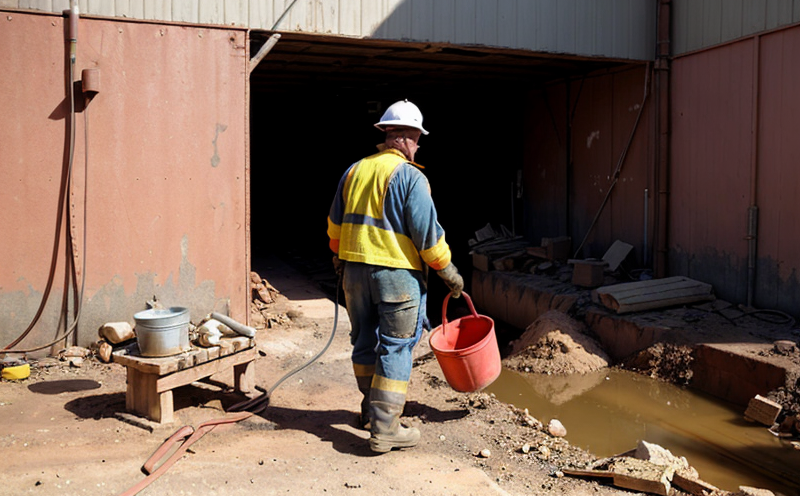DIN 33899 Dust Exposure in Mining Workplaces Testing
The DIN 33899 standard is a critical tool for ensuring occupational health and safety in mining environments. This method specifies the procedures to determine dust exposure levels within mining workplaces, which is essential for preventing respiratory diseases caused by inhaling harmful particulates. The test assesses airborne dust concentration, particle size distribution, and composition, thereby identifying potential risks to miners' health.
Mining operations inherently involve activities that generate significant amounts of dust, including rock drilling, blasting, crushing, and handling materials. Overexposure to respirable dust can lead to chronic respiratory conditions such as silicosis, pneumoconiosis, and bronchitis. The DIN 33899 test helps in identifying the types of dust present (e.g., silica, coal dust) and their concentrations, enabling mining companies to implement appropriate control measures.
The testing process involves collecting air samples using specialized sampling devices that are designed to capture airborne particulates accurately. These devices can be placed strategically within the mine environment to ensure they represent typical working conditions. After collection, the samples undergo analysis in a laboratory setting. The analytical methods used include gravimetric techniques and optical particle sizers, which provide precise measurements of dust concentration.
The standard also emphasizes the importance of personal protective equipment (PPE) for workers exposed to high levels of dust. By conducting regular DIN 33899 tests, mines can assess whether current PPE is sufficient or if additional protection is necessary. This proactive approach not only enhances worker safety but also aligns with regulatory requirements and corporate social responsibility goals.
Furthermore, the results of the DIN 33899 test are crucial for compliance purposes. Regulatory bodies such as OSHA (Occupational Safety and Health Administration) in the U.S., HSE (Health and Safety Executive) in the UK, and other national safety organizations require mining operations to adhere to strict dust exposure limits. By conducting these tests regularly, mines can demonstrate their commitment to worker safety and compliance with international standards.
In conclusion, DIN 33899 testing plays a vital role in safeguarding miners' health by providing accurate data on dust levels within the workplace. This information is essential for identifying risks, implementing control measures, ensuring regulatory compliance, and maintaining high standards of occupational safety and health.
Why It Matters
Dust exposure in mining workplaces poses significant health risks to workers, particularly those involved in underground mining activities. The inhalation of respirable dust can lead to serious respiratory diseases, including silicosis and pneumoconiosis. These conditions not only affect the quality of life but also increase healthcare costs for both individuals and employers.
The DIN 33899 standard is designed to mitigate these risks by providing a robust framework for measuring dust exposure levels. By adhering to this standard, mining operations can ensure that their working environments are safe and healthy, thereby protecting workers' long-term health. This proactive approach also helps in reducing the incidence of work-related illnesses, which can lead to higher productivity and lower absenteeism rates.
The importance of DIN 33899 testing cannot be overstated, especially given the global focus on occupational safety and environmental sustainability. By implementing this standard, mining companies demonstrate their commitment to responsible practices that benefit both workers and the environment. This not only enhances the company's reputation but also fosters a culture of safety and compliance within the organization.
Moreover, regulatory requirements and industry best practices mandate adherence to such standards. Mining operations that fail to comply risk legal action, fines, and reputational damage. Therefore, conducting DIN 33899 tests is not just an option but a necessity for maintaining operational excellence in the mining sector.
Customer Impact and Satisfaction
The implementation of DIN 33899 testing has a direct impact on customer satisfaction within the mining industry. By ensuring that dust exposure levels are kept within safe limits, mines can provide a safer working environment for their employees, which in turn leads to higher job satisfaction and lower turnover rates.
Customers who rely on mining operations for raw materials or other products benefit from knowing that these sources come from responsibly managed environments. This perception enhances the trust customers have in the reliability and quality of the products they receive. Additionally, mines that demonstrate a strong commitment to occupational safety are more likely to attract and retain top-tier talent, further boosting their operational efficiency.
The results of DIN 33899 tests also provide valuable data for continuous improvement initiatives within mining operations. By identifying areas where dust levels exceed acceptable limits, mines can implement targeted interventions to reduce exposure. This proactive approach not only enhances worker safety but also ensures compliance with international standards and best practices.
In summary, the benefits of DIN 33899 testing extend beyond mere regulatory compliance; they contribute significantly to improving customer satisfaction, enhancing operational efficiency, and fostering a culture of responsibility within mining operations.
International Acceptance and Recognition
DIN 33899 has gained widespread acceptance and recognition across the international mining community. This standard is widely used in countries that have stringent occupational safety regulations, such as Germany, South Africa, Australia, and various European nations.
The International Organization for Standardization (ISO) and other global bodies recognize DIN 33899 as a robust framework for measuring dust exposure levels within mining workplaces. This recognition underscores its importance in promoting consistent and reliable testing practices globally. Mines that adopt this standard can ensure their compliance with international standards, thereby reducing the risk of non-compliance penalties.
Moreover, the use of DIN 33899 is encouraged by various industry associations and organizations dedicated to occupational safety and health. These bodies provide guidance on implementing the standard effectively, ensuring that mines worldwide can benefit from its proven methodologies. The international acceptance of this standard also facilitates better collaboration between mining operations across borders, promoting a unified approach to workplace safety.
In conclusion, DIN 33899 is not just a regional standard; it is an internationally recognized tool for ensuring occupational health and safety in mining environments. By adhering to this standard, mines can demonstrate their commitment to global best practices and contribute to a safer and healthier workforce worldwide.





